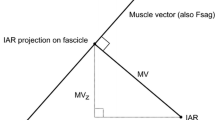Abstract
Purpose
Accessory attachments of the levator scapulae (LS) muscle have been described in the literature in previous cadaveric studies, but there is little knowledge about the incidence and distribution. Knowledge of LS accessory attachments is relevant to clinicians working in the fields of radiology, surgery, neurology, and musculoskeletal medicine. The purpose of this study was to explore the incidence and spectrum of LS caudal accessory attachments in vivo using magnetic resonance (MR) imaging in a young cohort.
Methods
MR images of the cervical spine were obtained from 37 subjects (13 males and 24 females) aged 18–36 years using an axial T1-weighted spin echo sequence acquired from a 3-Tesla MR scanner. The LS muscle was identified, and the presence of caudal accessory attachments was recorded and described.
Results
LS caudal accessory attachments were identified in 16 subjects (4 right, 6 left, and 6 bilateral; 12 female). Ten had unilateral accessory attachments to the serratus anterior, serratus posterior superior or the first/second rib. Four had bilateral accessory attachments to serratus anterior. One had bilateral accessory attachments to serratus posterior superior and unilateral accessory attachment to serratus anterior. One had bilateral attachments to both muscles.
Conclusions
Both unilateral and bilateral LS caudal accessory attachments were present in nearly half of the subjects examined. They were relatively more frequent in females than males. The findings indicate that these accessory attachments are common, and in some cases, those accessory attachments can occur bilaterally and to more than one site.


Similar content being viewed by others
References
Au J, Perriman DM, Pickering MR, Buirski G, Smith PN, Webb AL (2016) Magnetic resonance imaging atlas of the cervical spine musculature. Clin Anat 29:643–659. doi:10.1002/ca.22731
Chotai PN, Loukas M, Tubbs RS (2015) Unusual origin of the levator scapulae muscle from mastoid process. Surg Radiol Anat. doi:10.1007/s00276-015-1508-6
Conley MS, Meyer RA, Bloomberg JJ, Feeback DL, Dudley GA (1995) Noninvasive analysis of human neck muscle function. Spine 20:2505–2512
Elhassan BT, Wagner ER (2015) Outcome of triple-tendon transfer, an Eden-Lange variant, to reconstruct trapezius paralysis. J Shoulder Elb Surg 24:1307–1313. doi:10.1016/j.jse.2015.01.008
Erro R, Bhatia KP, Catania S, Shields K, Cordivari C (2013) When the levator scapulae becomes a “rotator capitis”: implications for cervical dystonia. Parkinsonism Relat Disord 19:705–706. doi:10.1016/j.parkreldis.2013.03.012
Goodman AL, Donald PJ (1990) Use of the levator scapulae muscle flap in head and neck reconstruction. Arch Otolaryngol Head Neck Surg 116:1440–1444
Loukas M, Louis RG Jr, Merbs W (2006) A case of atypical insertion of the levator scapulae. Folia Morphol 65:232–235
Macbeth RA, Martin CP (1953) A note on the levator scapulae muscle in man. Anat Rec 115:691–696. doi:10.1002/ar.1091150409
Mardones VF, Rodríguez TA (2006) Levator scapulae muscle: macroscopic characterization. Int J Morphol 24:251–258
Mayoux-Benhamou MA, Revel M, Vallee C (1997) Selective electromyography of dorsal neck muscles in humans. Exp Brain Res 113:353–360. doi:10.1007/bf02450333
Mori M (1964) Statistics on the musculature of the Japanese. Okajimas Folia Anat Jpn 40:195–300
Pu Q, Huang R, Brand-Saberi B (2016) Development of the shoulder girdle musculature. Dev Dyn 245:342–350. doi:10.1002/dvdy.24378
Rubinstein D, Escott EJ, Hendrick LL (1999) The prevalence and CT appearance of the levator claviculae muscle: a normal variant not to be mistaken for an abnormality. AJNR Am J Neuroradiol 20:583–586
Shaw AS, Connor SE (2004) Unilateral levator claviculae muscle mimicking cervical lymph node enlargement in a patient with ameloblastoma. Dentomaxillofac Radiol 33:206–207. doi:10.1259/dmfr/58465094
Shearman R, Tulenko F, Burke A (2011) 3D reconstructions of quail–chick chimeras provide a new fate map of the avian scapula. Dev Biol 355:1–11. doi:10.1016/j.ydbio.2011.03.032
Tiznado G, Bucarey S, Hipp J, Olave E (2015) Muscular variations of the neck: accessory fascicle of the levator scapulae muscle. Int J Morphol 33:436–439
Varjão LG, Cabral HR, Andrade DL, Lacerda NSO, Araújo VF, Masuko TS (2012) An unusual anatomical variation of the levator scapulae muscle. Int J Morphol 30:866–869
Wood J (1870) On a group of varieties of the muscles of the human neck, shoulder, and chest, with their transitional forms and homologies in the mammalia. Philos Trans R Soc Lond 160:83–116. doi:10.1098/rstl.1870.0007
Acknowledgments
We would like to acknowledge the participants who volunteered for this study, the support of the Royal Australian and New Zealand College of Radiologists Research Grant, the Canberra Hospital Private Practice Fund Research Grant and Summer Vacation Scholarship.
Author information
Authors and Affiliations
Corresponding author
Ethics declarations
Conflict of interest
The authors declare that they have no conflict of interest.
Ethical standards
The experiments in this study comply with the current laws of the country in which this study was performed.
Rights and permissions
About this article
Cite this article
Au, J., Webb, A.L., Buirski, G. et al. Anatomic variations of levator scapulae in a normal cohort: an MRI study. Surg Radiol Anat 39, 337–343 (2017). https://doi.org/10.1007/s00276-016-1727-5
Received:
Accepted:
Published:
Issue Date:
DOI: https://doi.org/10.1007/s00276-016-1727-5




